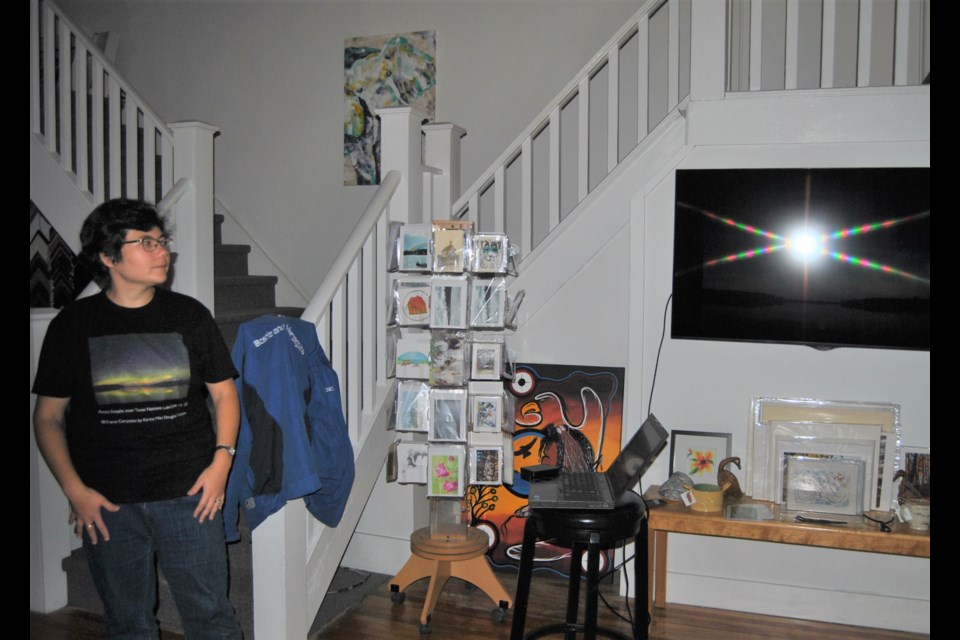Are you fascinated by those strange, colourful lights in the night sky?
Then you don’t want to miss Karina Douglas Takayesu’s photography exhibit on aurora borealis or the northern lights at the Black Spruce Gallery on 42 Pine Street S. in Timmins, Ont.
It’s a case of astronomy meeting art, with a series of visually stunning photographs taken by Takayesu this past July around the Timmins area of a phenomena caused by sun flares.
Douglas Takayesu’s exhibit “Northern Lights Near Home: A Photographic Exhibit opened this week at the Black Spruce Gallery on September 19 and runs till September 30th.
The Black Spruce Gallery hours are 10 a.m. to 5:30 p.m. It's Facebook page is here
One of Douglas Takayesu’s photographs is titled “Aurora arc over the McIntyre headframe”, that was taken at 3:07 a.m. on July 17, 2017.
The photograph is of a prominent green arc with hints of purple that spans over Pearl Lake and the McIntyre headframe in Schumacher. The headframe still has the Stars and Thunder logo projected on its front.
“Aurora borealis are caused by the activity on the sun,” explained Douglas Takayesu. “If an active part of the sun faces earth, it can send out flares of charged energy particles, mostly electrons and neutrons.”
“These charged particles are sent into space as solar winds and can reach speeds of a million miles an hour, when the wind heads towards earth we refer to the activity as space weather.”
Douglas Takayesu explained that some of the charged particles get past the earth’s magnetosphere and combine with oxygen and nitrogen molecules that produce the extra energy that gives off lights that we see as the northern lights or aurora borealis in the northern hemisphere.
A similar activity is seen in the southern hemisphere that is know as the southern lights or aurora australis
“The different molecules at different altitudes give us the different colours of lights that we see as the aurora borealis,” said Douglas Takayesu. “And by the way aurora also occur at the poles of other planets and moons.”
Every time you get the northern lights you also get the southern lights, but they are harder to see because there is less land mass in the southern hemisphere and less population so you must be out an opportune time to see them.
The northern lights on the other hand can be see most nights of the year depending on where you happen to be as it often is more visible on some areas than others.
As to why the northern lights are also referred to as the aurora borealis, Douglas Takayesu explained the origins.
“Aurora refers to the Roman goddess of the dawn and that is because when you look at the Northern Lights on a particular intense night, it almost feels as if dawn is approaching,” Douglas Takayesu explained.
“As for the borealis part, Boreas is the ancient Greek name for the north wind,” she added.
One of the first people to use the phrase aurora borealis was Galileo in 1616, according to Douglas Takayesu’s’ research.
The northern lights come in waves, just like the ocean, said Douglas Takayesu, one minute they are overpowering and then the next minute their gone, only to come back an hour later.
Why is viewing the northern lights so fascinating?
“To be able to see this natural phenomenon is incredible and no two viewing of the northern lights is the same, as they are constantly in motion, constantly changing,” Douglas Takayesu said explaining why she is fascinated by aurora borealis.
“It’s like witnessing a solar or lunar eclipse,” she added.
And like the thousands who plan trips and vacations to view the eclipse of the sun as happened this past August there are many people who go to great lengths to view the northern lights as well.
“Many people travel to Yellow Knife in the Northwest Territories to view the northern lights, where they book hotels and make an event of seeing them,” said Sawako Douglas.
Although Sawako has not journeyed to Yellowknife she has friends who have gone to see the northern lights there.
“Sometimes they go in winter when it is -40 Celsius, but the don’t mind as the hotel rents them parka’s so they can view the northern lights and stay warm while they do.”
“They also have thermal winter camping tents where they can run in to get warm,” she explained. “It’s almost like a religion to them!”
Recently another country, Finland, has been promoting itself as a place to watch aurora borealis according to Sawako Douglas.
“But you don’t have to go to Yellowknife or Finland to watch the northern lights in winter,” said Karina.
“Winter nights are some the best time to view the northern lights because the nights are longer so you have longer view hours and a greater chance of seeing them, and cold winter nights tend to be clearer.”
For those interested in keeping track of the best times to view the northern lights in the Timmins area Douglas Takayesu provided the following northern lights websites that provide info on the best times for viewing.
National Ocean and Atmospheric Administration 30 Minute Forecast



